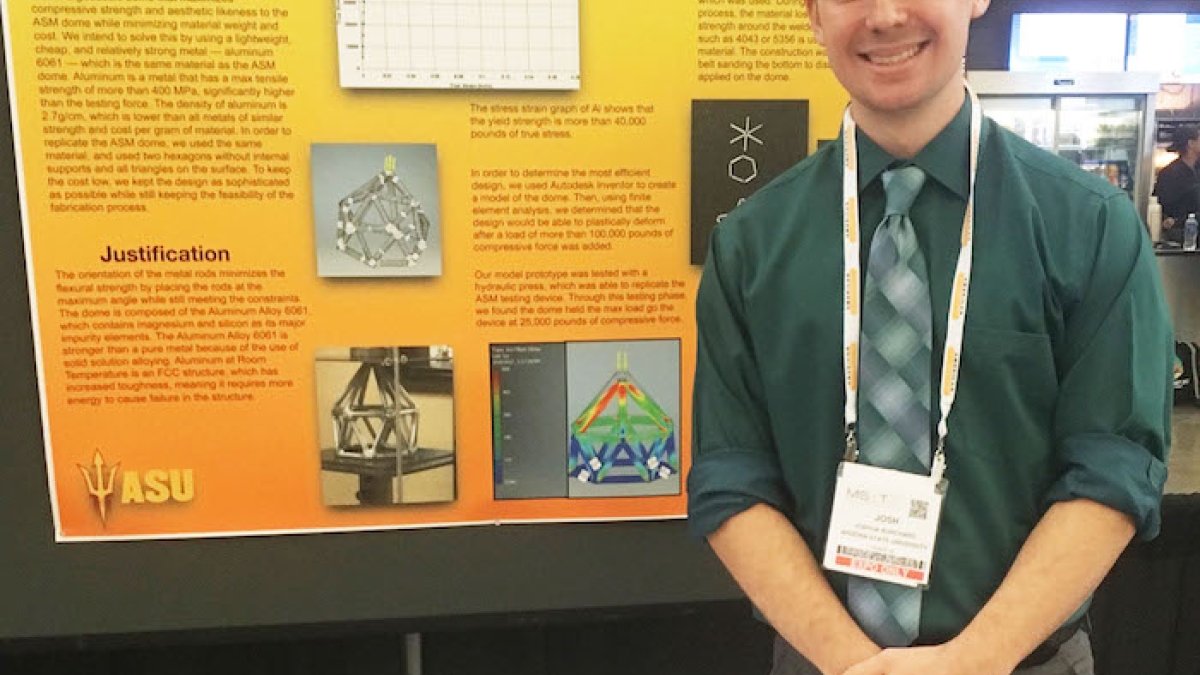Freshman team outranks upperclassmen in national 'Domesday' competition

Joshua Burchard helped lead the Tree Killers to a second place finish at the ASM Geodesic Dome Design Competition. Photo courtesy of Joshua Burchard
What began as a class project in Introduction to Engineering became a strong contender in the national Domesday ASM Geodesic Dome Design Competition for three freshman materials science and engineering students in Arizona State University's Ira A. Fulton Schools of Engineering.
Joshua Burchard, Bryan Ugaz and Sayquon Washington formed a team they called the “Tree Killers." Their design eventually moved on from being tested in the classroom to being tested against ten other teams in the national contest.
“This was our first competition like this, and we were competing against more experienced undergraduate and graduate students from universities throughout the country,” said Burchard, the team's student leader.
What made their project perform so well? Burchard points to the material selection of a lightweight aluminum, the dome aesthetics and the use of an element analysis program called Autodesk Inventor. By using the program, they predicted where the dome would fail and at what stress. They received the highest presentation score, likely due to their use of the technology.
“The material selection was extremely important because it set us apart from the 3-D-printed polymer domes, while being strong, cost effective and lightweight,” Burchard said.
Initially, they had difficulty with the dome’s fabrication process.
“I was able to find a professional aluminum TIG welder a half mile from campus who we paid to assemble our dome,” Burchard said.
During the presentation portion of the competition, the team stood before a panel of professional materials scientists from around the country to give an eight-minute pitch discussing materials selection, the creation process and details about costs and labor budgeting. Then, the teams answered questions posed by the judges.
The judges determined the winner based on aesthetics, verbal presentation, informational poster and the mechanical strength of their structure via compression testing.
“I think the structure performed very well because of the symmetry, avoidance of stress concentrations and good choice of lightweight materials,” President’s Professor James Adams said. “It was exceptional that a freshman team was about to out-compete many teams of upperclassmen.”
Adams, who was the faculty advisor for the team, was not allowed to give advice on the design or materials the team selected.
In the end Burchard, Ugaz and Washington placed second overall against eleven teams, and won a $750 prize.
“[The judges] were impressed with the fabrication on the dome, as it was by far the most intricate design of metal they had seen,” Burchard said. “It is relatively easy to have an intricate 3-D printed design, but to incorporate 31 polygons into the structure impressed them immensely.”
This marks the fourth year that ASU has placed in the top three teams at the competition.
“Materials science is one of the most rapidly developing fields technologically,” Burchard said, “and there will be many opportunities to improve existing technologies in the near future.”
More Science and technology

Indigenous geneticists build unprecedented research community at ASU
When Krystal Tsosie (Diné) was an undergraduate at Arizona State University, there were no Indigenous faculty she could look to…

Pioneering professor of cultural evolution pens essays for leading academic journals
When Robert Boyd wrote his 1985 book “Culture and the Evolutionary Process,” cultural evolution was not considered a true…

Lucy's lasting legacy: Donald Johanson reflects on the discovery of a lifetime
Fifty years ago, in the dusty hills of Hadar, Ethiopia, a young paleoanthropologist, Donald Johanson, discovered what would…